Genistein inhibits proliferation and induces senescence in neonatal mouse pituitary gland explant cultures
- PMID: 31593742
- PMCID: PMC6913926
- DOI: 10.1016/j.tox.2019.152306
Genistein inhibits proliferation and induces senescence in neonatal mouse pituitary gland explant cultures
Abstract
Genistein is an isoflavone abundant in soybean and infants are exposed to high levels of genistein in soy-based formula. It is known that genistein mediates estrogen receptor (ER) signaling, and exposure during neonatal development could cause acute and long term endocrine effects. We assayed genistein's impact on the neonatal mouse pituitary gland because it is an endocrine signaling hub and is sensitive to endocrine disruption during critical periods. Pituitary explant cultures, which actively proliferate and differentiate, were exposed to 0.06 μM-36 μM genistein and assayed for mRNA and protein changes. Genistein induced mRNA expression of the ERα regulated gene, Cckar, to the same magnitude as estradiol (E2) but with less potency. Interestingly, 36 μM genistein strongly inhibited pituitary proliferation, measured by a reduction in mKi67 mRNA and phospho-Histone H3 immunostaining. Examining cell cycle dynamics, we found that 36 μM genistein decreased Ccnb1 (Cyclin B1) mRNA; while mRNA for the cyclin dependent kinase inhibitor Cdkn1a (p21) was upregulated, correlated with an apparent increase in p21 immunostained cells. Strikingly, we observed a robust onset of cellular senescence, permanent cell cycle exit, in 36 μM genistein treated pituitaries by increased senescence activated β-galactosidase staining. We also found that 36 μM genistein decreased Bcl2 mRNA levels, a gene protective against apoptosis. Taken together these data suggest that genistein exposure during the neonatal period could initiate senescence and halt proliferation during a time when the proper numbers of endocrine cells are being established for mature gland function.
Keywords: Genistein; Pituitary; Proliferation; Senescence.
Copyright © 2019 Elsevier B.V. All rights reserved.
Conflict of interest statement
Declaration of interests
The authors declare that they have no known competing financial interests or personal relationships that could have appeared to influence the work reported in this paper.
Figures
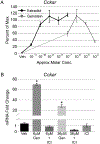
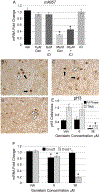
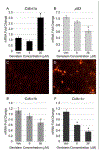
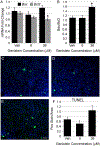
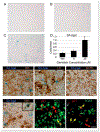
Similar articles
-
Bcl-2 overexpression sensitizes MCF-7 cells to genistein by multiple mechanisms.Int J Oncol. 2007 Oct;31(4):867-74. Int J Oncol. 2007. PMID: 17786319
-
[Proliferation inhibition and apoptosis onset in human ovarian carcinoma cell line SKOV3 induced by Genistein].Ai Zheng. 2003 Jun;22(6):586-91. Ai Zheng. 2003. PMID: 12948406 Chinese.
-
Isoliquiritigenin exhibits anti-proliferative properties in the pituitary independent of estrogen receptor function.Toxicol Appl Pharmacol. 2016 Dec 15;313:204-214. doi: 10.1016/j.taap.2016.09.027. Epub 2016 Oct 3. Toxicol Appl Pharmacol. 2016. PMID: 27702603
-
Cell Cycle Modulation of CHO-K1 Cells Under Genistein Treatment Correlates with Cells Senescence, Apoptosis and ROS Level but in a Dose-Dependent Manner.Adv Pharm Bull. 2019 Aug;9(3):453-461. doi: 10.15171/apb.2019.054. Epub 2019 Aug 1. Adv Pharm Bull. 2019. PMID: 31592434 Free PMC article.
-
A Comprehensive Review of Genistein's Effects in Preclinical Models of Cervical Cancer.Cancers (Basel). 2023 Dec 20;16(1):35. doi: 10.3390/cancers16010035. Cancers (Basel). 2023. PMID: 38201463 Free PMC article. Review.
Cited by
-
IMPACT OF REAL-LIFE ENVIRONMENTAL EXPOSURES ON REPRODUCTION: Impact of developmental exposures to endocrine-disrupting chemicals on pituitary gland reproductive function.Reproduction. 2024 Oct 18;168(6):e240072. doi: 10.1530/REP-24-0072. Print 2024 Dec 1. Reproduction. 2024. PMID: 39159262 Review.
-
Effects of Chronic Dietary Exposure to Phytoestrogen Genistein on Uterine Morphology in Mice.J Agric Food Chem. 2021 Feb 10;69(5):1693-1704. doi: 10.1021/acs.jafc.0c07456. Epub 2021 Feb 2. J Agric Food Chem. 2021. PMID: 33528250 Free PMC article.
-
Iodoacetic Acid, a Water Disinfection Byproduct, Disrupts Hypothalamic, and Pituitary Reproductive Regulatory Factors and Induces Toxicity in the Female Pituitary.Toxicol Sci. 2021 Oct 27;184(1):46-56. doi: 10.1093/toxsci/kfab106. Toxicol Sci. 2021. PMID: 34453833 Free PMC article.
-
Organoid models of the pituitary gland in health and disease.Front Endocrinol (Lausanne). 2023 Aug 8;14:1233714. doi: 10.3389/fendo.2023.1233714. eCollection 2023. Front Endocrinol (Lausanne). 2023. PMID: 37614709 Free PMC article. Review.
-
The Potential of Polyphenols in Modulating the Cellular Senescence Process: Implications and Mechanism of Action.Pharmaceuticals (Basel). 2025 Jan 22;18(2):138. doi: 10.3390/ph18020138. Pharmaceuticals (Basel). 2025. PMID: 40005954 Free PMC article. Review.
References
-
- Akiyama T, Ishida J, Nakagawa S, Ogawara H, Watanabe S, Itoh N, Shibuya M, Fukami Y, 1987. Genistein, a specific inhibitor of tyrosine-specific protein kinases. J. Biol. Chem 262, 5592–5. - PubMed
-
- Allred CD, Allred KF, Ju YH, Virant SM, Helferich WG, 2001. Soy diets containing varying amounts of genistein stimulate growth of estrogen-dependent (MCF-7) tumors in a dose-dependent manner. Cancer Res. 61, 5045–50. - PubMed
-
- Barlow J, Johnson JAP, Scofield L, 2007. Early Life Exposure to the Phytoestrogen Genistein and Breast Cancer Risk in Later Years. Fact Sheet on the Phytoestrogen Geinistein.
Publication types
MeSH terms
Substances
Grants and funding
LinkOut - more resources
Full Text Sources
Miscellaneous

